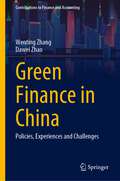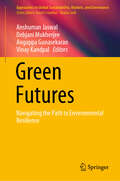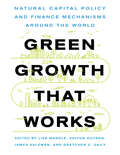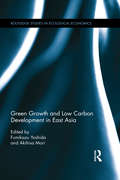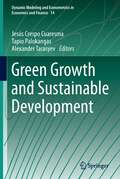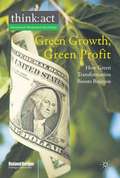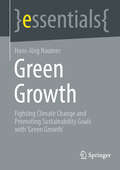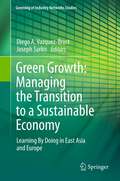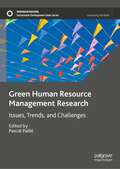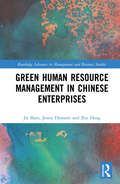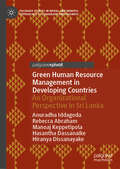- Table View
- List View
Green Finance and Decarbonization: Advancing Low-Carbon Technologies in East and Southeast Asia (Routledge-ERIA Studies in Development Economics)
by Farhad Taghizadeh-Hesary Fukunari Kimura Han Phoumin Rabindra NepalThis book explores empirical studies and policies related to green finance and low-carbon technology development through country-level case studies and regional analyses across East and Southeast Asia.Contributors explore how countries such as China, Indonesia, Japan, Lao PDR, Malaysia, the Philippines, the Republic of Korea, Singapore, Thailand, and Vietnam are leveraging green finance to advance their energy transitions and pursue carbon neutrality. The chapters examine regional efforts across East and Southeast Asia, with a focus on green technology innovation, green bond ecosystems, and renewable energy investments. By highlighting the role of green finance—including financial instruments, mechanisms, and policy frameworks—the book emphasizes the importance of coordinated efforts in promoting sustainable energy solutions and reducing carbon emissions.With valuable insights into effective practices for achieving global sustainability goals, this book will interest researchers of finance, energy economics, environmental economics, and policy.
Green Finance and Energy Transition: Innovation, Legal Frameworks and Regulation (Contributions to Finance and Accounting)
by Nadia Mansour Lorenzo M. Bujosa VadellEconomic models must evolve to avoid irreversible consequences for our planet in the face of climate change. The question is: How can we provide a growing population with access to affordable, viable energy while preserving our environment? Green finance is a pivotal concept that guides financial actions and operations toward fostering the energy transition and combating global warming. Finance, a key player in resource allocation, now incorporates an environmental dimension alongside the pursuit of economic profitability, setting it apart from 'traditional' finance. This book presents methods to provide a framework for financial transactions, support sustainable development, combat global warming, and enhance the transparency of financial product providers.
Green Finance and Renewable Energy in ASEAN and East Asia (Routledge-ERIA Studies in Development Economics)
by Farhad Taghizadeh-Hesary Fukunari Kimura Han PhouminGreen Finance and Renewable Energy in ASEAN and East Asia edited by Phoumin, Taghizadeh-Hesary and Kimura provides several empirical policy-oriented studies with new data on ASEAN member states and East Asian economies that deal with innovative and market-based solutions for unlocking private investments in renewable energy projects. In the wake of COVID-19, the importance of innovative ways and policies for enhancing investments in renewable energy projects to achieve climate-related goals is highlighted. Chapters cover various aspects and means of green finance for renewable energy development, including identifying the financing barriers and solutions for mitigating them, cleantech finance and energy transition, green investment risks, green technology financing, market development, carbon taxation, green bonds, FinTech, and green digital finance. The book collectively provides policy recommendations for designing funding strategies for renewable energy development in ASEAN and East Asia. A valuable resource to end-users, policymakers, and market players in ASEAN, East Asia, and the rest of the world on access to finance for renewable energy development.
Green Finance in China: Policies, Experiences and Challenges (Contributions to Finance and Accounting)
by Wenting Zhang Dawei ZhaoThis book aims to provide first-hand information for readers concerned with green finance and sustainable development by summarizing the unique features, policies and practical innovations of green finance development in China and hoping to provide China's experience in the development of green finance for more regions. The global economy is currently facing historic opportunities that brings by a new round of technology, energy and industrial revolution. The new growth path of "green and low-carbon" development has become the main direction of the transformation of global economic development. What's China's green finance strategy? How does China deliver on the goal? This book builds an overview of China's green finance and sheds light on sustainable development topics from finance perspective.
Green Finance in the European Union (Routledge International Studies in Money and Banking)
by Marta Postuła Mariusz LipskiWhile global challenges continue to reshape the here and now, public and corporate finance management needs to adapt quickly to increase the efficiency of institutions, enterprises and policies to face our new reality. There are very few publications that offer a comprehensive approach to the financing of environmental protection activities by the European Union. This book explores this topic from various angles and levels, as well as highlighting the determinants that influence micro- and macro-level decisions in this area.It presents an in-depth and unique analysis of the sources of funding for environmental measures implemented by European Union institutions, against the backdrop of national expenditure by Member States, and analyses the plausibility of the adopted targets in the run-up to 2050, in the context of the war in Ukraine and ad hoc energy policy solutions. This book is a voice in an ongoing discussion among the community of practitioners and theoreticians on sources of financing for the energy transition to achieve independence from Russian sources in the quickest possible timeframe. It demonstrates that environmental measures cannot occur without the financial participation of economic actors and financial institutions, particularly the capital market, and further underscores the scale of involvement in environmental projects, as measured by the value of green loans and green bonds covered by European financial institutions. The authors offer policy recommendations for financing activities related to environmental policy, notably energy transition.This book will appeal to scholars, students and researchers of corporate finance, banking, strategic and public finance management as well as polic-ymakers and practitioners involved in green finance investments.
Green Finance: Erfolgreiche Schritte zur grünen Unternehmensfinanzierung (essentials)
by Hans-Werner Grunow Christoph ZenderIn diesem essential beschreiben Hans-Werner Grunow und Christoph Zender den Grundgedanken und die Entwicklung von Green Finance und dessen Einsatzmöglichkeiten in der Unternehmensfinanzierung. Die Autoren skizzieren die Entstehung von Green Finance und zeigen Unterschiede zu konventionellen Finanzierungen auf. Es wird beschrieben, in welchen Fällen Green Finance eingesetzt wird, welche Instrumente in Frage kommen und welche Prozesse durchlaufen werden. Behandelt werden außerdem die Green-Finance-Pläne der Europäischen Union.
Green Futures: Navigating the Path to Environmental Resilience (Approaches to Global Sustainability, Markets, and Governance)
by Angappa Gunasekaran Debjani Mukherjee Vinay Kandpal Anshuman JaswalThis book presents a comprehensive examination of the complex journey toward achieving environmental resilience in the twenty-first century. It brings together leading voices from various fields to showcase the challenges and promising solutions in sustainability and green futures. Organized into thematic divisions, each chapter presents a different facet of environmental resilience, offering incisive analysis, creative techniques, and case studies from around the globe. The book explores the complex intersections of environmental, social, and economic elements, including climate change mitigation and adaptation, sustainable urban development, biodiversity conservation, and renewable energy technology. Contributions from distinguished scholars, policymakers, activists, and practitioners encourage interdisciplinary discourse and collaboration to address urgent environmental challenges. The book inspires readers to envision and actively contribute to a more sustainable and resilient future through rigorous research, visionary thinking, and practical ideas. Combining intellectual rigor with approachable prose, this book serves as an invaluable resource for students, scholars, policymakers, and anyone committed to creating a greener and more resilient society. It provides vital information and inspiration for navigating the path toward environmental resilience, whether dealing with the complexity of climate change, seeking innovative solutions for sustainable development, or advocating for environmental justice.
Green Gentrification: Urban sustainability and the struggle for environmental justice (Routledge Equity, Justice and the Sustainable City series)
by Tammy L. Lewis Kenneth A. GouldGreen Gentrification looks at the social consequences of urban "greening" from an environmental justice and sustainable development perspective. Through a comparative examination of five cases of urban greening in Brooklyn, New York, it demonstrates that such initiatives, while positive for the environment, tend to increase inequality and thus undermine the social pillar of sustainable development. Although greening is ostensibly intended to improve environmental conditions in neighborhoods, it generates green gentrification that pushes out the working-class, and people of color, and attracts white, wealthier in-migrants. Simply put, urban greening "richens and whitens," remaking the city for the sustainability class. Without equity-oriented public policy intervention, urban greening is negatively redistributive in global cities. This book argues that environmental injustice outcomes are not inevitable. Early public policy interventions aimed at neighborhood stabilization can create more just sustainability outcomes. It highlights the negative social consequences of green growth coalition efforts to green the global city, and suggests policy choices to address them. The book applies the lessons learned from green gentrification in Brooklyn to urban greening initiatives globally. It offers comparison with other greening global cities. This is a timely and original book for all those studying environmental justice, urban planning, environmental sociology, and sustainable development as well as urban environmental activists, city planners and policy makers interested in issues of urban greening and gentrification.
Green Giants: How Smart Companies Turn Sustainability into Billion-Dollar Businesses
by E. WilliamsWhat do Brazil&’s top beauty brand, America&’s second-fastest-growing restaurant chain, and the world&’s third bestselling car have in common--besides achieving enormous success with revenue in the tens of billions? They are doing it all while holding to their convictions of implementing sustainable principles that help consumers live better lives. But they aren&’t the only ones. Green Giants examines nine companies--including Chipotle, Toyota, Unilever, Tesla, General Electric, and more--who have established the blueprint for sustainable success that anyone can follow. Author Freya Williams, an early pioneer of the modern sustainable business movement, discovered six factors responsible for the overwhelming success of these nine socially responsible companies:The Iconoclastic LeaderDisruptive InnovationA Higher PurposeBuilt In, Not Bolted OnMainstream AppealNew Behavioral ContractPacked with eye-opening research, exclusive interviews, and enlightening examples, Green Giants serves as your blueprint for merging wild profitability with social responsibility.
Green Gold: Contested Meanings and Socio-Environmental Change in Argentine Yerba Mate Cultivation (SpringerBriefs in Latin American Studies)
by Adam S. DohrenwendThis book applies an approach to study the externalization of cost under capitalism in the production of Argentine yerba mate, an infusion with stimulant properties long used by indigenous peoples. Consumption in today’s globalized economy makes it difficult to understand the consequences of our actions across the globe. A political-ecological lens, informed by the work of Robert Sack and Ian Cook, can help guide an analysis that geographically reconstructs supply chains and reveal the realities of consumption. The use of yerba mate has become a cornerstone of Argentine society and identity, and yerba mate processors are working to expand exports globally. In Argentina’s Misiones Province, the heart of yerba mate production, the true costs of production are borne by the children, the impoverished laborers, and the environment of Argentina’s Atlantic Rainforest. These consequences of modernity, along with the efforts of an NGO to remedy them, are presented and assessed.
Green Gone Wrong: How Our Economy Is Undermining the Environmental Revolution
by Heather RogersIn Green Gone Wrong environmental writer Heather Rogers blasts through the marketing buzz of big corporations and asks a simple question: Do today’s much-touted "green" products—carbon offsets, organic food, biofuels, and eco-friendly cars and homes—really work? Implicit in efforts to go green is the promise that global warming can be stopped by swapping out dirty goods for "clean" ones. But can earth-friendly products really save the planet? This far-reaching, riveting narrative explores how the most readily available solutions to environmental crisis may be disastrously off the mark. Rogers travels the world tracking how the conversion from a "petro" to a "green" society affects the most fundamental aspects of life—food, shelter, and transportation. Reporting from some of the most remote places on earth, Rogers uncovers shocking results that include massive clear-cutting, destruction of native ecosystems, and grinding poverty. Relying simply on market forces, people with good intentions wanting to just "do something" to help the planet are left feeling confused and powerless.Green Gone Wrong reveals a fuller story, taking the reader into forests, fields, factories, and boardrooms around the world to draw out the unintended consequences, inherent obstacles, and successes of eco-friendly consumption. What do the labels "USDA Certified Organic" and "Fair Trade" really mean on a vast South American export-driven organic farm? A superlow-energy "eco-village" in Germany’s Black Forest demonstrates that green homes dramatically shrink energy use, so why aren’t we using this technology in America? The decisions made in Detroit’s executive suites have kept Americans driving gas-guzzling automobiles for decades, even as U.S. automakers have European models that clock twice the mpg. Why won’t they sell these cars domestically? And what does carbon offsetting really mean when projects can so easily fail? In one case thousands of trees planted in drought-plagued Southern India withered and died, releasing any CO2 they were meant to neutralize. Expertly reported, this gripping exposé pieces together a global picture of what’s happening in the name of today’s environmentalism. Green Gone Wrong speaks to anyone interested in climate change and the future of the natural world, as well as those who want to act but are caught not knowing who, or what, to believe to protect the planet. Rogers casts a sober eye on what’s working and what’s not, fearlessly pushing ahead the debate over how to protect the planet.
Green Growth That Works: Natural Capital Policy and Finance Mechanisms from Around the World
by Gretchen Daily Lisa Mandle Zhiyun Ouyang James E. SalzmanRapid economic development has been a boon to human well‑being, but comes at a significant cost to the fertile soils, forests, coastal marshes, and farmland that support all life on earth. If ecosystems collapse, so eventually will human civilization. One solution is inclusive green growth—the efficient use of natural resources. Its genius lies in working with nature rather than against it. Green Growth That Works is the first practical guide to bring together pragmatic finance and policy tools that can make investment in natural capital both attractive and commonplace. Pioneered by leading scholars from the Natural Capital Project, this valuable compendium of proven techniques can guide agencies and organizations eager to make green growth work anywhere in the world.
Green Growth and Low Carbon Development in East Asia (Routledge Studies in Ecological Economics)
by Akihisa Mori Fumikazu YoshidaThe concept of green growth, coupled with one of green economy and low carbon development, is a global concern especially in the face of the multiple crises that the world has faced in recent years - climate, oil, food, and financial crises. In East Asia, this concept is regarded as the key in transforming cheap-labour dependent, export-oriented industries towards a more sustainable development. Green Growth and Low Carbon Development in East Asia examines the beginnings of low carbon, green growth in practice in East Asia and how effectively it has directed East Asian nations, especially Korea, China and Japan, to put environment and climate challenges as the core target zone for investment and growth. Special focus is paid to energy and international trade - areas in which these nations compete with pioneered nations of Europe and the United States to develop renewable energy industries and enhance their international competitiveness. On the basis of the lessons learned in East Asia, together with a comparison of Russia, this book discusses the applicability and limitations of this developmental approach taken by the developing nations and resource-rich emerging economies, including the conditions and contexts in which nations are able to transition into sustainable development through the use of low carbon, green growth strategies.
Green Growth and Sustainable Development
by Tapio Palokangas Jesús Crespo Cuaresma Alexander TarasyevThe book examines problems associated with green growth and sustainable development on the basis of recent contributions in economics, natural sciences and applied mathematics, especially optimal control theory. Its main topics include pollution, biodiversity, exhaustible resources and climate change. The integrating framework of the book is dynamic systems theory which offers a common basis for multidisciplinatory research and mathematical tools for solving complicated models, leading to new insights in environmental issues.
Green Growth, Green Profit
by Roland BergerGreen business is here. It is a multi billion business with enormous growth potential, driven by megatrends such as demographic change, climate change and urbanization. It is driving the transformation of existing businesses and changing the way customers and suppliers act, forcing them to rethink their business strategy.
Green Growth: Fighting Climate Change and Promoting Sustainability Goals with 'Green Growth' (essentials)
by Hans-Jörg NaumerIn this Springer essential, you will learn how market-driven methods, innovations, and investments can achieve "Green Growth" without forgetting the needs of the three billion people who already lack these essentials today. In the context of sustainability goals, the differences between "Green Growth" and "Degrowth" are explained, and why climate change cannot be stopped with a "war economy". Instead, the environment must be given a price tag. Through "Finance For Future", there is a chance to change the world for the better through one's own investments. A win-win-win situation for the environment, investors, and the economy. The author donates the proceeds from the sales to Hessen-Forst.
Green Growth: Learning By Doing in East Asia and Europe
by Joseph Sarkis Diego A. Vazquez-BrustThis volume is a practical guide that helps the reader build a quick, evidence-based understanding of green-growth strategies and challenges. Its cogent analysis of real-life case studies enables policy makers and company executives identify successful strategies they can adopt, and pitfalls they can avoid, in drafting and implementing green growth policies. The contributors' empirical assessment of these studies identifies the structural conditions required for economic growth to be compatible with environmental sustainability and how the transition to a new economic paradigm should be managed. A crucial addition to the debate now beginning in earnest around the world, this volume attempts to understand how we can nurture a new-born model of sustainable growth and help it evolve to maturity.
Green HRM: A Climate Conscious Route to Triple Bottom Line
by Soni Agrawal Roma PuriEnvironment management and sustainability have become hackneyed terms in management parlance, but they are surprisingly underrated in their practical applications. Do organizations see sustainability as a solo initiative of a department to fulfil the statutory requirements or is it an investment towards the well-being of people, planet and profitability? If so, then how important is the contribution of HR towards the greening of an organization? The book is an industrious guide on Green HR and sustainability practices towards fulfilling the three-pronged goals of triple bottom line. Through the success stories of employees as change agents, it showcases how Green HRM can mesh sustainability with strategy by linking organizational factors such as vision and mission, leadership, organizational culture and employees’ pro-environmental attitude with the organization’s profit goals. The book presents a compelling picture of an ideal green workplace and how HRM can influence pro-environmental behaviour in the organization and society.
Green Horizons: Role of AI in Sustainable Finance
by Syed Hasan Jafar Shakeb Akhtar Mahfooz Alam Nassir Ul Haq WaniThis book explores the intersection of artificial intelligence and sustainable finance, offering a comprehensive analysis of AI's transformative impact on the global financial landscape. It demystifies the complex relationship between AI and sustainability, highlighting the unprecedented opportunities and challenges that arise when these forces converge. Through real-world case studies, cutting-edge research, and expert insights, the book elucidates how AI can drive environmentally conscious decision-making in finance. It discusses how machine learning algorithms, data analytics, and predictive modeling can help integrate environmental, social, and governance (ESG) considerations into investment strategies. Going beyond theory, the book provides actionable guidance for financial professionals, policymakers, and technologists. It emphasizes the need for ethical and responsible AI applications and addresses potential pitfalls and safeguards against unintended consequences. This book serves as a pivotal resource for those interested in harnessing AI's potential in sustainable finance. It offers a roadmap for harmonious coexistence between AI and sustainable finance, contributing to a more resilient and equitable global economy. With its comprehensive analysis and interdisciplinary approach, the book is valuable for scholars, policymakers, practitioners, and general readers seeking to understand and navigate the complex issues surrounding AI and sustainable finance.
Green Households: Domestic Consumers, the Environment and Sustainability
by Klaas Jan Noorman Ton Schoot UiterkampHouseholds are one of the main sources of waste and of other environmental impacts. This is a study of domestic consumption. Drawing on empirical research largely from The Netherlands, it takes households as consumer units and examines the entire household metabolism. This includes the way domestic demand can influence where and how goods and services are produced, resource flows through households, and the differential impacts of different lifestyles. It shows both what would constitute sustainable domestic consumption and how far there is to go to achieve this.
Green Human Resource Management Research: Issues, Trends, and Challenges (Sustainable Development Goals Series)
by Pascal PailléIn contemporary times, most organizational functions (such as finance, marketing, and supply chains) have assessed their impact on the environment. HR has lagged behind other disciplines in discussions of sustainability, though the literature on this topic has grown significantly in recent years. This book, engaging SDGs 4 and 8, among others, examines green HRM from a variety of perspectives. Divided into three sections, it explores the process of human resource acquisition, the connection between green HRM practice and employee behavior, and international perspectives of green HRM. The final chapter presents a summary analysis of topics discussed in the book and outlines potential future paths of research for the field. This volume, featuring leading researchers from across the globe, further develops this emerging field for HR and organizational behavior scholars.
Green Human Resource Management in Chinese Enterprises (Routledge Advances in Management and Business Studies)
by Jie Shen Jenny Dumont Xin DengCorporate social responsibility (CSR), and particularly environmental management, has now become a global social norm. As the largest developing economy in the world, China is currently a major environmental polluter. This book examines how Chinese enterprises, including both indigenous firms and foreign-owned organizations operating in China, utilize human resource management (HRM) to conduct environmental management, i.e. green HRM, also referred to as environmentally friendly HRM. Green HRM integrates HRM with environmental management and is implemented by firms to realize corporate green strategies by providing opportunities and motivating employees to become involved in environmental activities. This book explores how green recruitment and selection, green training, green performance management, and green pay and rewards are managed in Chinese enterprises, and how green HRM affects organizational green and non-green workplace behaviors. It enriches the current literature on green HRM practices and measures. It also advances our understanding of employee organizational behavioral consequences of green HRM, which is an emerging and understudied field of research. As such, this book offers practical implications on how to elicit desirable employee green and non-green workplace behaviors through green HRM policies and practices. This book will appeal to anyone interested in learning more about green HRM practices and the social and psychological processes through which green HRM influences employees, promotes green workplace behaviors and improves a firm's environmental performance.
Green Human Resource Management in Developing Countries: An Organizational Perspective in Sri Lanka (Palgrave Studies in Moral and Mindful Approaches to Leadership and Business)
by Anuradha Iddagoda Rebecca Abraham Manoaj Keppetipola Hasantha Dassanaike Hiranya DissanayakeThis book describes green human resource management as practices undertaken by organizations' human resource departments to create supportive environments in which employees can thrive and perform in their most productive capacity. Focusing on the Sri Lankan military, it examines the case of successful green initiatives by theoretically and empirically linking green human resource management, high performance work practices, leadership, and virtues to green orientation and green employee engagement. The authors posit that green initiatives can only be successful if they win the hearts and minds of employees through cognitive engagement, emotional engagement, and behavioral engagement. Aimed at academics in HRM and organizational behavior, this work develops theoretical frameworks to examine green human resource management in developing countries.
Green Human Resource Management: A View from Global South Countries
by M. Y. Yusliza D. W. S. RenwickThis book offers a fresh perspective on Green Human Resource Management (Green HRM) by focusing on the Global South's industries and cultures. It takes a scientific approach, using evidence to show how sustainable practices in HR can promote environmental goals. The book contributes significantly to the understanding of both the theory and real-world impact of Green HRM. The book offers a wealth of information on various approaches making it not only an intriguing read but also an informative and insightful reference for Green HRM experts all over the world.
Green Hydrogen in Chile
by Tarun Khanna Mariana Cal Jenyfeer Martinez BuitragoIn 2020, the Chilean government wants to promote green hydrogen, a technology with high potential to help mitigate climate change. President Sebasti n Pi era, aware of the country's advantages to produce green hydrogen competitively, asks Energy Minister Juan Carlos Jobet to elaborate a mission-oriented strategy to promote the technology. The strategy was to match the government's center-right orientation and the country's political and economic trajectory. Chile was often praised for its strong macroeconomic fundamentals and a sound policy framework. However, the country was facing social and economic disruptions given the Covid-19 pandemic, which added pressure to an already difficult political backdrop. Chile still struggled with unprecedented political uncertainty after social unrest in 2019 led to a wave of protests that forced the government to agree to a constitutional reform and greater social spending.



